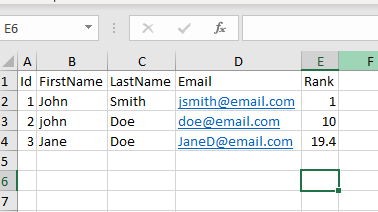C# 技巧 :从 Excel 文件中读取数据

我们希望有一种更隐含的方式来读取数据,并通过在对象属性上使用属性将其添加到对象中。
使用列字母的地图

让我们看一下下面的 Excel 文件,因为我们可以看到它包含一个用户列表。
我们可以用以下类来表示用户数据:
public class ReadByColumnName
{
[PropertyColumnAttribute("A")]
public int Id { get; set; }
[PropertyColumnAttribute("B")]
public string FirstName { get; set; }
[PropertyColumnAttribute("C")]
public string LastName { get; set; }
[PropertyColumnAttribute("D")]
public string Email { get; set; }
[PropertyColumnAttribute("E")]
public double? Rank { get; set; }
}
如您所见,我们使用属性将属性映射到列字母。
属性本身非常简单,我们只是用它来保存列字母。
[AttributeUsage(AttributeTargets.Property, AllowMultiple = false)]
public class PropertyColumnAttribute : Attribute
{
public string ColumnName;
public PropertyColumnAttribute(string columnName)
{
ColumnName = columnName;
}
}
让我们看看如何使用它来读取 Excel 数据:
public static class ExcelReader
{
public static List<T> ReadExcel<T>(string filePath,
string worksheetName = null,
int initialDataRow = 2) where T : class, new()
{
ExcelPackage.LicenseContext = LicenseContext.NonCommercial;
using var package = new ExcelPackage(filePath);
//read the first worksheet or a specific one
var sheet = worksheetName == null ?
package.Workbook.Worksheets.FirstOrDefault() :
package.Workbook.Worksheets.FirstOrDefault(s => s.Name == worksheetName);
var list = new List<T>();
var properties = GetProperties<T>();
for (var i = initialDataRow; i < sheet.Dimension.End.Row + 1; i++)
{
var item = new T();
foreach (var property in properties)
{
var value = sheet.Cells[$"{property.Column}{i}"].Value;
property.PropertyInfo.SetValue(item,
value != null ?
Convert.ChangeType(value, property.Type) :
property.IsNullable ? null : default);
}
list.Add(item);
}
return list;
}
private static List<PropertyInfoModel> GetProperties<T>()
{
var list = new List<PropertyInfoModel>();
foreach (var property in typeof(T).GetProperties())
{
var propertyColumnAttribute = property.GetCustomAttribute<PropertyColumnAttribute>();
if (propertyColumnAttribute != null )
{
var isNullable = property.PropertyType.IsGenericType &&
property.PropertyType.GetGenericTypeDefinition() == typeof(Nullable<>);
list.Add(new PropertyInfoModel
{
PropertyInfo = property,
Name = property.Name,
Column = propertyColumnAttribute?.ColumnName ,
IsNullable = isNullable,
Type = isNullable ? property.PropertyType.GetGenericArguments()[0] : property.PropertyType
});
}
}
return list;
}
}
public class PropertyInfoModel
{
public PropertyInfo PropertyInfo { get; set; }
public string Name { get; set; }
public string Column { get; set; }
public Type Type { get; set; }
public bool IsNullable { get; set; }
}
ReadExcel<T> 方法获取 3 个参数:
- filePath:Excel 文件的路径
- worksheetName:我们要读取的工作表的名称,如果为 NULL,则读取第一个工作表
- initialDataRow:包含数据的第一行,如果未传递,将使用 2。
首先,我们需要获取要阅读的工作表。如果 worksheetName 参数为 null,我们将读取文件中的第一个工作表,如果它不是 NULL,我们将查找具有该名称的工作表。
其次,我们需要读取我们想要读入的类 T 的属性。GetProperties<T>() 使用反射来循环访问类属性并查找具有 PropertyColumnAttribute 属性的类属性。对于这些属性,我们得到:
- PropertyInfo 对象。
- 属性名称。
- 来自 PropertyColumnAttribute 的列字母。
- 属性类型。
- 如果该属性为 NULLABLE
现在我们有了元数据,我们遍历所有行(从 initialDataRow 开始)
对于每一行,我们遍历所有类属性,并尝试在该行中获取该属性的单元格值
var value = sheet.Cells[$"{property.Column}{i}"].Value;
现在,我们使用 propertyInfo 对象将此值添加到我们为该行创建的项中
property.PropertyInfo.SetValue(item,
value != null ?
Convert.ChangeType(value, property.Type) :
property.IsNullable ? null : default);
请注意,我们检查值是否为 NULL,如果是,我们将进行第二次检查以查看属性是否为 null,并相应地设置 NULL 或默认值。
如果该值不是 NULL,则将其转换为正确的 Type。
使用列标题的地图
当您将单个工作表映射到单个类时,使用列字母进行映射非常有用,但是如果您有一个需要从不同 Excel 文件类型获取数据的类,该怎么办?例如,我们有一类 Users,但我们从几个供应商那里获得了包含用户数据的 Excel 文件,如果所有列的顺序可能不同。因此,通过标题将列映射到属性更为方便。
让我们看看我们的类会是什么样子:
public class ReadByColumnTitle
{
[PropertyTitleName("Id")]
public int Id { get; set; }
[PropertyTitleName("FirstName")]
public string FirstName { get; set; }
[PropertyTitleName("LastName")]
public string LastName { get; set; }
[PropertyTitleName("Email")]
public string Email { get; set; }
[PropertyTitleName("Rank")]
public double? Rank { get; set; }
}
PropertyTitleNameAttribute 也非常简单:
[AttributeUsage(AttributeTargets.Property, AllowMultiple = false)]
public class PropertyTitleNameAttribute : Attribute
{
public string ColumnTitle;
public PropertyTitleNameAttribute(string columnTitle)
{
ColumnTitle = columnTitle;
}
}
我们是这样使用它的:
public static class ExcelReader
{
public static List<T> ReadExcelUsingTitles<T>(
string filePath,
string worksheetName = null,
Func<string, string, bool> titleCompareDelegate = null,
int titleRow = 1,
int initialDataRow = 2) where T : class, new()
{
ExcelPackage.LicenseContext = LicenseContext.NonCommercial;
using var package = new ExcelPackage(filePath);
var sheet = worksheetName == null ?
package.Workbook.Worksheets.FirstOrDefault() :
package.Workbook.Worksheets.FirstOrDefault(s => s.Name == worksheetName);
titleCompareDelegate ??= (a, b) => a.Trim() == b.Trim();
var list = new List<T>();
var properties = GetProperties<T>();
var propertyToColumnMapping = new Dictionary<int, PropertyInfoModel>();
//titles
for (var col = 1; col < sheet.Dimension.End.Column + 1; col++)
{
var title = sheet.Cells[titleRow, col].Value?.ToString();
if (title != null)
{
var property = properties.FirstOrDefault(s => titleCompareDelegate(s.Column, title));
if (property != null)
{
propertyToColumnMapping.Add(col, property);
}
}
}
//data
for (var row = initialDataRow; row < sheet.Dimension.End.Row + 1; row++)
{
var item = new T();
foreach (var (col, property) in propertyToColumnMapping)
{
var value = sheet.Cells[row, col].Value;
property.PropertyInfo.SetValue(item,
value != null ?
Convert.ChangeType(value, property.Type) :
property.IsNullable ? null : default);
}
list.Add(item);
}
return list;
}
private static List<PropertyInfoModel> GetProperties<T>()
{
var list = new List<PropertyInfoModel>();
foreach (var property in typeof(T).GetProperties())
{
var propertyColumnAttribute = property.GetCustomAttribute<PropertyColumnAttribute>();
var propertyTitleNameAttribute = property.GetCustomAttribute<PropertyTitleNameAttribute>();
if (propertyColumnAttribute != null || propertyTitleNameAttribute != null)
{
var isNullable = property.PropertyType.IsGenericType &&
property.PropertyType.GetGenericTypeDefinition() == typeof(Nullable<>);
list.Add(new PropertyInfoModel
{
PropertyInfo = property,
Name = property.Name,
IsNullable = isNullable,
Type = isNullable ?
property.PropertyType.GetGenericArguments()[0] :
property.PropertyType,
Column = propertyColumnAttribute?.ColumnName ??
propertyTitleNameAttribute.ColumnTitle,
});
}
}
return list;
}
}
public class PropertyInfoModel
{
public PropertyInfo PropertyInfo { get; set; }
public string Name { get; set; }
public string Column { get; set; }
public Type Type { get; set; }
public bool IsNullable { get; set; }
}
ReadExcelUsingTitles<T> 方法获取 3 个参数:
- filePath:Excel 文件的路径
- worksheetName:我们要读取的工作表的名称,如果为 NULL,则读取第一个工作表
- titleCompareDelegate:这是一个代表,我们用来将列标题与属性属性进行比较,如果未传递任何内容,则将使用内置委托。
- titleRow:标题行的编号,如果未传递,将使用 1。
- initialDataRow:包含数据的第一行,如果未传递,将使用 2。
首先,我们需要获取要阅读的工作表。如果 worksheetName 参数为 null,我们将读取文件中的第一个工作表,如果它不是 NULL,我们将查找具有该名称的工作表。
我们还检查 titleCompareDelegate 是否为 NULL,如果是,我们将使用以下委托
titleCompareDelegate ??= (a, b) => a.Trim() == b.Trim();
其次,我们需要读取我们想要读入的类 T 的属性。GetProperties<T>() 使用反射来循环访问类属性,并查找具有 PropertyColumnAttribut 属性或 PropertyTitleNameAttribute 属性的类属性。对于这些属性,我们得到:
- PropertyInfo 对象。
- 属性名称。
- 来自 PropertyColumnAttribute 的列字母或_来自 PropertyTitleNameAttribute_ 的列标题。
- 属性类型。
- 如果该属性为 NULLABLE
处理的第一步是遍历标题行,将属性映射到标题,并创建列号到属性信息的字典
var propertyToColumnMapping = new Dictionary<int, PropertyInfoModel>();
//titles
for (var col = 1; col < sheet.Dimension.End.Column + 1; col++)
{
var title = sheet.Cells[titleRow, col].Value?.ToString();
if (title != null)
{
var property = properties.FirstOrDefault(s => titleCompareDelegate(s.Column, title));
if (property != null)
{
propertyToColumnMapping.Add(col, property);
}
}
}
然后,我们遍历所有数据行,并针对每一行遍历列到属性字典中的每个项目。
//data
for (var row = initialDataRow; row < sheet.Dimension.End.Row + 1; row++)
{
var item = new T();
foreach (var (col, property) in propertyToColumnMapping)
{
var value = sheet.Cells[row, col].Value;
property.PropertyInfo.SetValue(item,
value != null ?
Convert.ChangeType(value, property.Type) :
property.IsNullable ? null : default);
}
list.Add(item);
}
对于每个列到属性的链接,我们获取单元格值并将其添加到项目中。请注意,我们处理 NULL 值和对象转换,就像我们按列字母读取数据时所做的那样.
源代码获取:公众号回复消息【code:69873】

 code:69873 获取下载地址
code:69873 获取下载地址